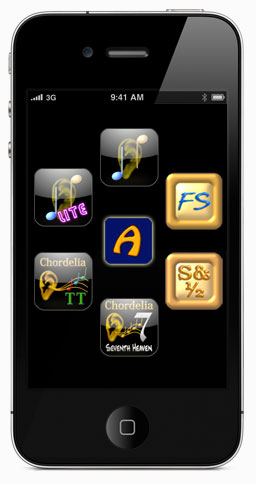 Last week we introduced you to iAction: a fantastic new iOS app for goal setting, progress tracking, and the support you need to keep you on course. We think it’s a great complement to our ear training apps and today we’re going to look in more detail at how it can help you in your journey to expert musicianship.
Last week we introduced you to iAction: a fantastic new iOS app for goal setting, progress tracking, and the support you need to keep you on course. We think it’s a great complement to our ear training apps and today we’re going to look in more detail at how it can help you in your journey to expert musicianship.
In our last post we had a quick overview of the features of iAction and gave you some idea of how it can be used with our apps. Now let’s look in more detail at how it can support your ear training.
Competition! The developers of iAction have given us a few free copies of the app to give away to our readers! See details at the end of this post…
iAction for your ears
Here at Easy Ear Training we define “ear training” as anything you do to improve the way you hear. The key point being: anything you do!
iAction is the perfect ‘manager’ for your ear training, because it’s built around defining what you want to accomplish, breaking it down into concrete tasks, and then getting helpful reminders to support you in carrying out those tasks.
Let’s look at some examples of “big picture goals” you might have as an ear training student:
- Learn to recognise intervals in ascending, descending and harmonic form
- Reliably distinguish diminished and minor triad chords
- Finally learn the difference between all the types of seventh chord
- Learn to jam along with music on your instrument
With all of these, if you simply think “I’d like to be able to do that some day” and dabble now and then, unfortunately you’re not going to make much progress. Ear training is something where regular training (ideally daily) really pays off – your ears get more and more attuned. Leave too long between practice sessions, and you’ll find you never really improve or reach your goals.
So rather than just airily dreaming of these goals… decide you are going to do them. Write them down. iAction makes it easy.
And then, here’s the real trick: Break them down into bite-sized chunks. Often the best approach is to split each goal into sub-goals, and then figure out some regular targets or occasional milestones which will track your progress on those sub-goals. Let’s see what that might look like for our examples:
- Learn to recognise intervals in ascending, descending and harmonic form
- Practice ascending intervals up to a Perfect 5th [Daily]
- Practice all the ascending intervals in RelativePitch [Daily]
- Practice the descending forms [Daily]
- Practice the harmonic forms [Daily]
- Take a full test to check progress [Every Monday morning]
- Reliably distinguish diminished and minor triad chords
- Practice Major and Minor thirds in RelativePitch [Daily]
- Practice Minor and Diminished root position triads in Chordelia: Triad Tutor [Daily]
- Practice Min. and Dim. triads (all inversions) in Chordelia: Triad Tutor [Daily]
- Take a full test to check progress[Every Monday morning]
- Learn the difference between all the types of seventh chord
- Practice with Chordelia: Seventh Heaven [Daily]
- Read up on jazzadvice.com [Every Friday night]
- Practice listening to jazz records [Every Sunday, ’round midnight]
The text in square brackets just indicates how often you plan on taking action for these sub-goals. In the language of iAction, we’ve defined our 3 “long-term goals”, and then set up a few “short-term goals” for each one. We can set “events” for those short-term goals, which have a set time and can repeat. So they might be one-offs (e.g. “Pass the final exam on 25th June”) or regular (e.g. “Train with RelativePitch every day at 6:30PM”).
Three steps to success in ear training
So let’s take a look at one of our examples in detail, using iAction. Suppose we want to reliably distinguish diminished and minor triad chords.
Step 1: Define your goal
First things first, we’ll set our main “long-term” goal, “Master min & dim chords”:
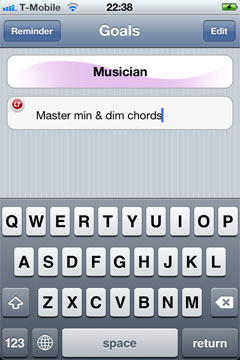
Define your main ear training goal
Next we’ll break it down into “short-term” goals:
Step 2: Plan regular action
You’ll notice that glaring red text in the picture above – iAction wants to make sure we won’t forget! So let’s add events for these sub-goals. Because we want to make swift progress let’s train every day, and plan on one week for each sub-goal. We can always adjust these later depending on our progress:
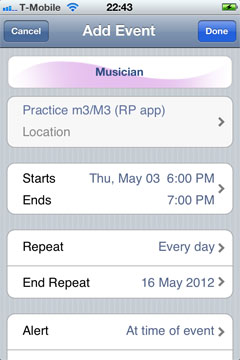 Set up daily reminders |
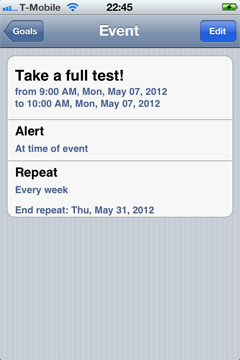 Set up occasional events for milestones |
Step 3: Train and improve!
Once you’ve set up your goals and events, you can rely on iAction to prompt you when the time comes, and remind you to take action. If you find yourself going off the expected schedule, no problem: you can adjust your goals and events at any time.
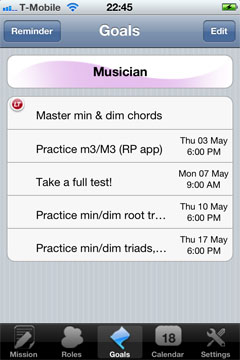 Aural Skills Development - all planned out |
iAction is packed with helpful guidance in the app, and there are even a few surprises along the way to help keep you motivated! Find out more on the App Store page.
Don’t delay… Take action. (iAction!)
Probably the single biggest thing you can do to ensure your aural skills improve is to commit to regular practice. The way you practice may be with apps, downloads, online study materials or just some good old-fashioned active listening – but what matters most is that you stick with it, day after day.
We all wish we had will of steel and unflappable commitment, but the truth is we all need a bit of help to stay on track and reach our goals. iAction is a truly helpful assistant for reaching your full potential and becoming the musician you’ve always dreamed of being.
Competition!
The developers of iAction have given us 3 free copies of the app to give away to our readers! To enter the contest and win a copy of this app (worth $13.99) simply leave a comment below telling us your current ear training goals. We’ll choose a winner at random on May 9th.

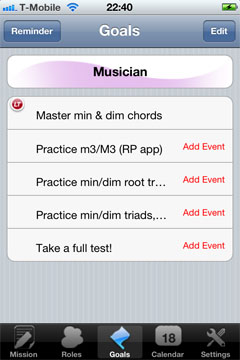
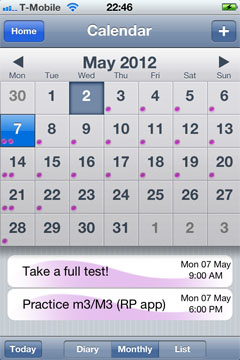






I have a goal to make it into a very good choir, no the best choir. But I struggle hearing major and minor thirds. I also have to pass a written theory test at 80% or better. Lots to learn before I can tryout.
That's a great goal! Singing is such an uplifting way of expressing yourself :)
Have you tried our new interval training pack? Or the Introducing Intervals album? Both cover major and minor thirds. If you'd like a preview of the material in the training album just let me know.
Do you play an instrument as well as singing? I always found that practising major and minor arpeggios on my instrument drilled the sounds of major and minor thirds into my head…!
As a relative beginner I've both struggled with hearing things by ear, and having the confidence to think I could do so. This app has helped enormously in both respects!
It's a great article you've written with some great ideas, and I'd like to share this 3 minute talk on TED that might also help
http://www.ted.com/talks/matt_cutts_try_something…
The idea to try something new for 30 days was brilliant for me. It doesnt't feel as daunting, and I've been able to commit to training every day for the past 2 weeks already. Being competitive, I now want to keep it going without missing any more days.
iAction looks like it would be great for me as it'll focus me on daily training for 30 days and beyond!
My goal is to play the keyboard by ear. I also struggle with major and minor thirds.
Excellent! Thirds can be tricky… You may find that using major and minor scales as a reference (e.g. singing up the scale in your head and seeing if it matches) can be a good way to distinguish thirds – at least, when you're practising at leisure in your home!
I'm happy to say you were selected at random as one of our three winners! Please shoot me an email at [email protected] to get your download code.
My goal is to be able to instantly play harmonies I hear inside while improvising on my instrument. Currently I'm working on recognizing and naming harmonic and melodic intervals from seconds up to 7ths.
My goal is to improve my ear as a musician and improviser. Formal ear training helps me also when i´m transcribing music and in playing situation, reacting other players on the bandstand.
Great stuff, Petri! You might find that setting more specific goals can make it easier to stay motivated, especially when using the iAction app. For example, choosing a particular track to transcribe in the next week, or being able to improvise over a particularly tricky song…
You were selected (at random) as one of the three winners in our contest! Please send me an email at [email protected] and I'll give you your download code.
My short term goal is to improve my ear to distinguish triad- and seventh chord inversions.
My long term goal is to be a versatile improviser and to be better at transcribing music.
Both excellent goals! Hearing chord inversions in a real musical context is a formidable skill and well worth working towards. You'll find the improvements in your appreciation of harmony pay off elsewhere too.
Hopefully our Chordelia apps can be of some assistance. We may also be publishing some chord training MP3s like our new interval training tracks soon.
I just started learning to play guitar less than a year ago, I’ve always wanted to learn. At the age of 46 it seems that this is my time, I want to be able to express myself through music, I have a lot to say. I think this will help me to acheive that goal, Then watch out I will be heard!!!!
I'm a professional guitar player and have always struggled with ear training , your programs have defenetly helped my progress but I feel I'm still a long way off from where I want to be, my current goal is to be able to chat a whole tune in one listen with out my instrument and to be able to hear vocal harmony parts . I feel that this new app will really help me reach my goals quicker, thanks so much!
I want to establish permanent relative pitch to a level that will allow me to enter the conservatory
That's a really good ambition to have. Relative pitch is a hugely versatile skills, in both its melodic and harmonic forms.
Best of luck with your ear training, and I hope you'll be walking into the conservatory soon!
Sounds like a very interesting app for musicians in need of that ‘little extra’.
My goal is to improve my error detection in rehearsals – both vocal and instrumental.
That's very interesting… Could you tell me more about the kind of error detection you want to improve on?
I'd love to know what chord is coming next in a song by knowing what it sounds like rather than having to read the music.
Ah, forseeing the future… a worthy goal indeed! ;)
Understanding common chord progressions is something we've been talking about a lot here lately. A useful skill for any musician, and especially guitar players and song-writers.
I'm delighted to say your answer was picked randomly as one of our three winners! Please get in touch ([email protected]) to claim your free download.
My goal: Recognizing intervals in an improvised solo, on the fly. And, by the way, EarTraining is great!
Sometimes intervals slip by me and I cannot distinguish one from the other. I would love to be more accurate. I love to improvise and it would help me with composition also. I would also like to help some of my students with this area.
Fantastic! It's always wonderful to hear from a teacher who is still passionate about improving their own skills.
I hope you'll find our new interval training pack might be of some use – and we'd really welcome any feedback from you or your students!
I need a good app to help me with melodic dictation. I always have problem with this. This app could help me solving my problem.
Melodic dictation is a good skill to focus on. It can be seen as a combination of relative pitch and rhythm skills, and most people struggle more with the relative pitch side.
Our Step and a Half app focuses specifically on this, but you may find our other (free) study materials and downloadables useful.
The iAction app would definitely be a helpful aid, as the key to improving your melodic dictation will be…. regular practice! Good luck :)
iAction is a great tool for someone that needs an assistant in their pocket. For artists it will help us stay on track with our goal while allowing us to improve on a daily basis regarding all aspects of our craft. I am a person who constantly wants to improve vocally, performance wise ect.
That's a great attitude, Kiana! And you're right that the iAction app can really help with these kinds of ambition.
I'm afraid you didn't win a copy this time – but try our Facebook and Twitter giveaways which still have a little time left!
Thanks again to all our entrants!
Good luck with your ear training goals – and if you need a helping hand, we're always happy to lend an ear ;)